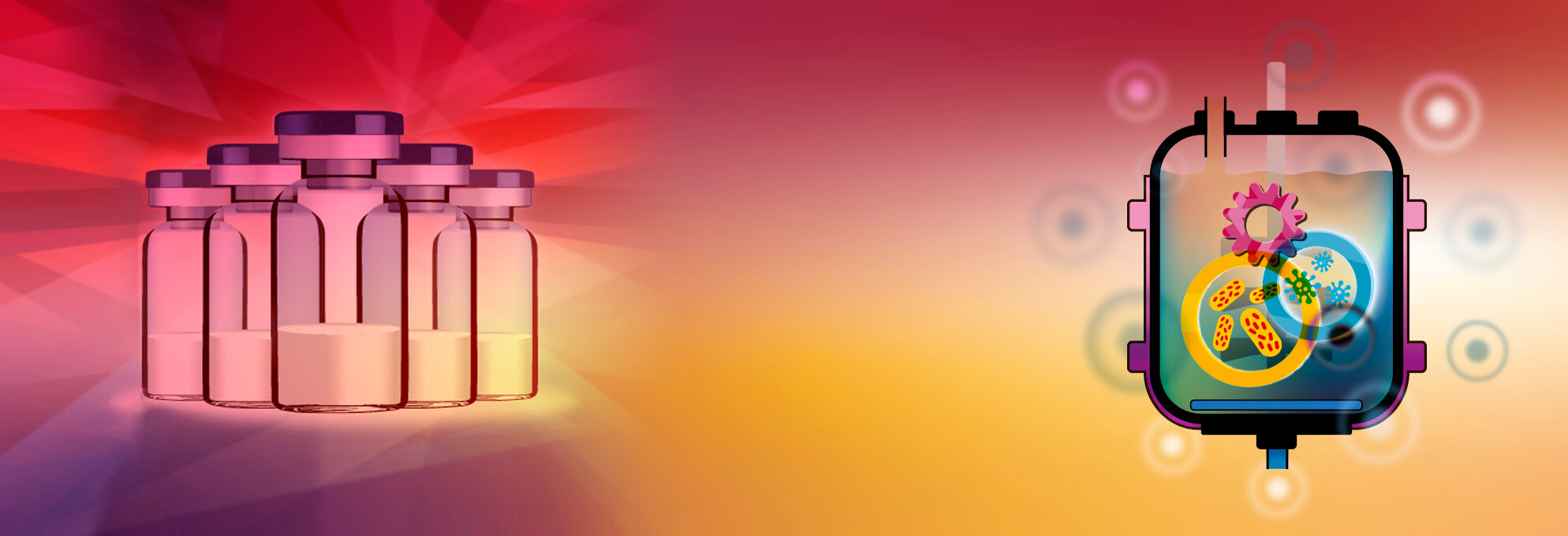PDA BioManufacturing and Lyophilization Conferences: The Start of a Shared Journey

The 2021 PDA BioManufacturing Conference, held in parallel with the 2021 PDA Lyophilization Conference, brought together a large audience representing industry, suppliers, research institutes, and regulators. Building on the technological capabilities of previous conferences, the two meetings were presented jointly 14-15 September on one virtual platform that provided participants a full conference experience with opportunities to connect and interact.
Focusing on “Biomanufacturing in the New Era,” and “Lyophilization in Parenteral Drug Manufacturing” this year’s conference included real-time presentations, interactive Q&A sessions with speakers and panelists, a session of the PDA Vaccines Interest Group, a live Poster Lounge and various networking sessions that allowed in-depth discussions on topics covered in the program. This article highlights some key learnings from the 2021 event.
Joint Opening Plenary: Advancing Biomanufacturing in a New Era
With the COVID-19 pandemic driving the need for the global supply and distribution of vaccines and other therapeutics, biomanufacturing has played a critical role in enabling innovative approaches to product development, as well as production at sufficiently large scales.
In addition to industry’s contributions, regulatory authorities provided essential input enabling implementation of novel acceleration strategies, with potential updates to current regulatory practices that could be triggered by other worldwide health crises. The joint plenary session provided a platform to share perspectives from both regulators and industry on how to enable rapid and broad access to biopharmaceuticals.
An overview of the recently published draft EMA “acceleration toolbox guidance,” along with an insightful EMA analysis of the learnings from the COVID-19 pandemic, triggered discussion about CMC acceleration enablers. Industry perspectives on CMC strategy and technology innovations, for example using digitalization, completed the presentations, which were followed by a final panel discussion and live Q&A session. Several possible ideas about innovative CMC strategies to advance the distribution and availability of novel biological products were identified:
- Digitalization
- New manufacturing technologies and evolution in compliance expectations
- Acceleration options (CMC and regulatory framework)
Full implementation of these strategies could be aided by quality systems and quality regulations, a culture shift and continued dialogue with regulators; and costs, resources and consideration of the return on investments.
The majority of the conference program offered concurrent sessions following two separate tracks: “Product Development and Control Strategies” and “Innovation – Drivers, Enablers & Benefits.” Day 2 opened with a Scientific Poster Lounge, an interactive Q&A with poster presenters, and closed with a plenary session discussing what was learned from the pandemic and a look into the future. In each session, perspectives from industry best practices, regulatory agencies, and research institutes were brought together to fuel a discussion around applying innovative approaches and technologies and stimulate the learning experience of all participants.
Product Development and Control Strategies
Analytical Technologies and Strategies
Participant feedback showed the conference was highly successful, an outcome made possible due to the experienced PDA Europe staff and organizing committees. The conference program was developed by the dedicated scientific organizing committee, which included:
- Cristiana Campa, GSK (Co-chair BioManufacturing)
- Raf De Dier, Janssen (Co-chair Lyophilisation)
- Michael De Felippis, Eli Lilly and Company (Co-chair BioManufacturing)
- Anthony Cannon, MSD (Co-chair Lyophilisation)
- Marta Antunes, MSD
- Thomas Beutler, GEA
- Glen Bolton, Amgen
- Lucia Ceresa, Charles River
- Richard Denk, Skan
- Walid Elazab, Steris
- Thomas Frank, Refolution
- Thierry Gastineau, Sanofi
- Julian Gitter, Bayer
- Sebastian Groël, LMU
- Maik Guttzeit, Bayer
- Sabine Hauck, Leukocare
- Susanne Joerg, Lonza (now Ten23)
- Jörg Lümkemann, F. Hoffmann–La Roche
- Yves Mayeresse, GSK
- Arnaud Paris, Biomerieux
- Jonny Parsons, Amgen
- Sascha Pfeiffer, Lyo Engineering
- Kevin Smyth, IPS
- Sebastian Teitz, Asahi Kasei Bio
- Elisabeth Vachette, Sartorius Stedim
- Mark Van Ooij, Janssen
- Diane Wilkinson, AstraZeneca
Regulatory thinking is constantly evolving to increase product understanding during process development and process changes. This session focused on the impact of the new draft ICH Quality Guideline Q14: Analytical Procedure Development on different products from both regulatory and industry perspectives. From the discussion, it was evident that the quality by design (QbD) framework applied to analytical procedure development and lifecycle requires a clear assessment of the attributes to be tested in the context of the overall control strategy and allows sound method development and lifecycle, supporting changes. The relevance of comparability strategies and reference standard development to support process improvements and enable reliable testing of biopharmaceuticals was also highlighted.
Control Strategies
The development of the control strategy requires an understanding of the process and of the variables that may impact the critical quality attributes (CQA). Therefore, the manufacturer tends to identify process variabilities or contamination sources during development and gain process understanding throughout the product lifecycle to define the controls that would prevent process failure. Several examples from manufacturers and suppliers were shared in this context on environmental monitoring, risk-based identification of CQA limits for mAbs testing, and vaccine product and process development. The highlighted the importance of QbD-driven approaches to enable rapid development and reliable control strategies, and the relevance of the partnership between manufacturers and suppliers to design effective control strategies.
Drug Product & Stability Predictions
The session explored accelerated predictive stability and stability modeling along with in vivo stability. Both the presentations and the Q&As showed that predictive stability modeling can be successfully applied to accelerate development of biotherapeutics and vaccine products, considering shelf-life determination and transportation/handling conditions. Key enablers for predictive stability modeling include prior knowledge, advanced kinetic modeling, understanding the degradation mechanism and clinically relevant limits for CQAs, and regulatory acceptance. Discussions concluded that the impact on the stability of several factors beyond temperature should be considered in physiological conditions, and a future perspective could include AI-driven models. (Stability modeling for vaccines was also discussed during the Vaccine Interest Group meeting on Day 1.)
Innovation – Drivers, Enablers & Benefits
Innovations in BioManufacturing
The biomanufacturing sector of the pharmaceutical industry is one of the most innovative global industries. This session focused on strategies for facilities, technology and manufacturing for next-generation bioprocessing. Presentations touched on the digital twin for process development, considerations for upstream and downstream process intensification, next-generation bioprocessing facilities, and model-based process space identification. The benefits of such evolution of QbD-driven control strategies were identified as increased process understanding to ensure consistent product quality, CMC development efficiency and acceleration of product to patient, manufacturing flexibility and reduced facility footprint, lower Cost of Goods and Cost of Development, and increased process productivity.
Supply Chain and Facilities
Since the COVID-19 pandemic, there has been significant concern over the ability of biomanufacturers to maintain reliable supply chains and timely production. Biomanufacturers expended enormous amounts of resources to bring about innovative solutions that allowed delivery of vaccines to the patients in an unprecedented timeline. Testimonials and great solutions presented in this session described how to overcome critical raw material shortages, build new facilities, rethink the complete vaccines manufacturing process, and stimulate greater efficiency. In this context, innovation can be enabled by minimizing the impact of changes through risk assessments and mitigation strategies, anticipating future manufacturing needs with flexible, prefabricated and evolutive facilities, and improving process and product understanding by applying PAT tools.
Tech Transfer – Regulatory and Technical Considerations
The registration and maintenance of products worldwide is often cumbersome and unpredictably lengthy, which can lead to delays in access to patients, especially in emerging countries. Leveraging platform knowledge and shared knowledge across industry and health authorities is key to accelerating the registration and commercialization of innovative technologies. The presentations and discussion highlighted the need for continuous Improvement, considering inconsistent legislative frameworks, requirements, procedures, and timelines for post-approval changes. The importance of the increased application of prior knowledge, risk-based approaches and information management was also emphasized. Dramatic improvement can be achieved through global alignment and harmonization of requirements that can ensure product supply and prevent shortages. In addition, right-first-time, streamlined technology transfers and accelerated commercialization are key enablers for enhancement. Participants were informed that the revision of PDA Technical Report No. 65 (Revised 2022): Technology Transfer expands on the current version with an additional focus on knowledge transfer.
2021 PDA Lyophilization Conference
This year’s conference presented a variety of topics focused on lyophilization as a biomanufacturing technology. Modules provided information on handling and stability, simulation and modeling, process control and manufacturing trends and novel methods. Speakers shared examples of industry best practices, as well as novel approaches from within industry, supply and research institutes. Each session was preceded by a virtual exhibition and poster session. The opening plenary session was held jointly with the 2021 PDA BioManufacturing Conference.
Stability of Lyophilized Products
The case studies presented in this session highlighted how the ongoing applied research has diversified tremendously in recent years. More specifically, when considering stabilization of a lyophilized product, the best improvements are achieved when the focus is not directed solely on individual components of process parameters and formulation components, but on the combination and synergistic effects of all aspects that tie into a lyophilized product. That takes into account the full range of factors from formulation to processing, as well as primary and secondary packaging.
Simulation and Modeling
In this session, further developments over the last years were shown in the field of freezing and pore network modeling, where historically substantial emphasis has been put on primary drying modeling. As a result, using these models in combination with process development work allows for the maximum optimization potential of product stability.
Novel Approaches in Process Development and Control
The implementation and utilization of process analytical technologies has grown steadily in the biopharmaceutical industry. With the introduction of new technologies, such as infrared as a viable method for predicting optimized cycle parameters, industry has seen the potential for advanced control strategies of lyophilization processes, even with the possibility for large-scale commercial applications. Also, approaches that allow container traceability enable a number of advantages for commercial applications that provide important information from the beginning of the manufacturing process to the final packaging and, ultimately, to patient use.
Equipment and Manufacturing Trends
Presentations in this session demonstrated that, despite lyophilization being an “old” technology, continued investments are being made into new lyophilization facilities or the expansion of existing operations. Several great examples were highlighted of novel approaches being used for operations and maintenance that came out of years of operational expertise. And in the last sessions, participants received a glimpse into advances that are being made to improve the energy efficiency and refrigerant systems of our lyophilization processes to align to global green manufacturing guidelines and advance the sustainability goal of our biomanufacturing operations.
Green Manufacturing—Novel Materials & Methods
In the final session, participants received a glimpse into the future of lyophilization. Speakers presented on the industry advances being made to improve the energy efficiency of refrigeration systems. The goal is to align lyophilization processes to global green manufacturing guidelines and advance the sustainability of biomanufacturing operations.
Joint Closing Plenary Session: Learnings from the Pandemic and Looking Toward the Future
The COVID-19 outbreak challenged traditional approaches and timelines for the development and manufacture of vaccines and therapeutics, fostering the use of innovative technologies and CMC strategies. In this session, Speakers from the Coalition for Epidemic Preparedness Innovations (CEPI) and cross-industry task forces provided an overview of CMC and regulatory learnings that resulted. A panel discussion among thought leaders from EMA, CEPI and industry focused on how to apply what was learned from this experience that can speed future biopharmaceutical innovation and ensure we are better prepared for potential public health emergencies in the future. The topics nicely linked to the opening conference session, reflecting a global perspective on how to leverage cross-industry acceleration lessons from COVID-19 to set the stage for health emergency preparedness. To implement the proposals for improvement discussed during the conference, panelists agreed on the importance of continuing cross-industry dialogue and collaborations, fostering guidance from cross-regulatory agencies and national control laboratories, and driving continuous innovation in biomanufacturing technologies and control strategies.
The combined event of the 2021 PDA BioManufacturing Conference and 2021 PDA Lyophilization Conference provided an excellent forum to share key knowledge. We look forward to continuing our collaboration in 2022.
The combined 2022 conference is scheduled to be held on 20-21 September in Amsterdam. The conference planning committee will provide more details in an upcoming article for the PDA Letter.



 Cristiana Campa, PhD, is currently a Technical R&D Advisor and Fellow at GSK Vaccines, with involvement in CMC development portfolio support and scientific advocacy, focusing on CMC strategies and innovation. She has more than 20 years of experience in biologics and related analytical and development approaches gained in different universities and companies. She joined Novartis Vaccines in 2006, focusing on the development validation, and transfer of analytical methods for the release and characterization of several vaccine products, first as a senior manager and then as Head of Analytical Development, Italy. Since 2012, Cristiana has worked on Quality by Design (QbD) principles implementation for vaccines. Since the acquisition of Novartis Vaccines by GSK in 2015, she has been the Head of QbD Integration and, until June 2018, the Head of Science and Development Practices in Technical R&D, covering QbD implementation, Knowledge Management, and Development roadmaps.
Cristiana Campa, PhD, is currently a Technical R&D Advisor and Fellow at GSK Vaccines, with involvement in CMC development portfolio support and scientific advocacy, focusing on CMC strategies and innovation. She has more than 20 years of experience in biologics and related analytical and development approaches gained in different universities and companies. She joined Novartis Vaccines in 2006, focusing on the development validation, and transfer of analytical methods for the release and characterization of several vaccine products, first as a senior manager and then as Head of Analytical Development, Italy. Since 2012, Cristiana has worked on Quality by Design (QbD) principles implementation for vaccines. Since the acquisition of Novartis Vaccines by GSK in 2015, she has been the Head of QbD Integration and, until June 2018, the Head of Science and Development Practices in Technical R&D, covering QbD implementation, Knowledge Management, and Development roadmaps. Michael R. DeFelippis, PhD, is a Distinguished Research Fellow in the Bioproduct Research and Development division of Eli Lilly and Company. In this senior scientific leadership position, he is responsible for providing strategic technical direction to the CMC activities for the Lilly biopharmaceutical product portfolio with specific emphasis on characterization of physicochemical properties, analytical development, process and product development, control strategy definition, and preparation of CMC-related regulatory documentation to support product licensure in global markets.
Michael R. DeFelippis, PhD, is a Distinguished Research Fellow in the Bioproduct Research and Development division of Eli Lilly and Company. In this senior scientific leadership position, he is responsible for providing strategic technical direction to the CMC activities for the Lilly biopharmaceutical product portfolio with specific emphasis on characterization of physicochemical properties, analytical development, process and product development, control strategy definition, and preparation of CMC-related regulatory documentation to support product licensure in global markets. Raf De Dier, PhD, is Associate Director Advanced Technology at The Janssen Pharmaceutical Companies of Johnson & Johnson. He holds a master’s degree in Chemical Engineering and obtained his PhD at the University of Leuven in Belgium and ETH Zürich in Switzerland. He joined Janssen R&D in 2016, where he was responsible for the process development and tech transfer support for liquid and lyophilized drug products in the parenteral fill-finish pilot plant. As part of the Manufacturing Science & Technology group, he has also led various process improvement projects, with an emphasis on lyophilization. Currently, he is Associate Director for Advanced Technology in the Biologics Clinical Supply organization, where he drives the proof-of-concept evaluation and implementation of new scientific initiatives across the biologics manufacturing sites of Janssen R&D.
Raf De Dier, PhD, is Associate Director Advanced Technology at The Janssen Pharmaceutical Companies of Johnson & Johnson. He holds a master’s degree in Chemical Engineering and obtained his PhD at the University of Leuven in Belgium and ETH Zürich in Switzerland. He joined Janssen R&D in 2016, where he was responsible for the process development and tech transfer support for liquid and lyophilized drug products in the parenteral fill-finish pilot plant. As part of the Manufacturing Science & Technology group, he has also led various process improvement projects, with an emphasis on lyophilization. Currently, he is Associate Director for Advanced Technology in the Biologics Clinical Supply organization, where he drives the proof-of-concept evaluation and implementation of new scientific initiatives across the biologics manufacturing sites of Janssen R&D. Anthony Cannon, is currently Director, External Manufacturing Technical Operations, for SM Sterile Products at MSD located in Lucerne, Switzerland. He is responsible for technical support of Sterile SM drug products for external manufacturing operations for the SM and Antibiotics platforms. He has held various positions throughout his career in Sterile Drug Product development and manufacturing with a focus on formulation and process development of both liquid and lyophilized parenteral, final container development and optimization, medical devices, and drug delivery. He has over 25 years in the industry with experience in biologics (plasma products, proteins, peptides, liposomes, vaccines; viral and bacterial), small molecules, nanocrystals, medical devices, reagents, nutraceuticals and cytotoxic, focused on lyophilization development and manufacturing. He has also presented on the fundamental of lyophilization, formulation, process development, thermal characterization, finished product analysis, and scale up and tech transfer at various conferences, seminars and pharmaceutical and biotech companies in North America, Europe, and Asia.
Anthony Cannon, is currently Director, External Manufacturing Technical Operations, for SM Sterile Products at MSD located in Lucerne, Switzerland. He is responsible for technical support of Sterile SM drug products for external manufacturing operations for the SM and Antibiotics platforms. He has held various positions throughout his career in Sterile Drug Product development and manufacturing with a focus on formulation and process development of both liquid and lyophilized parenteral, final container development and optimization, medical devices, and drug delivery. He has over 25 years in the industry with experience in biologics (plasma products, proteins, peptides, liposomes, vaccines; viral and bacterial), small molecules, nanocrystals, medical devices, reagents, nutraceuticals and cytotoxic, focused on lyophilization development and manufacturing. He has also presented on the fundamental of lyophilization, formulation, process development, thermal characterization, finished product analysis, and scale up and tech transfer at various conferences, seminars and pharmaceutical and biotech companies in North America, Europe, and Asia.